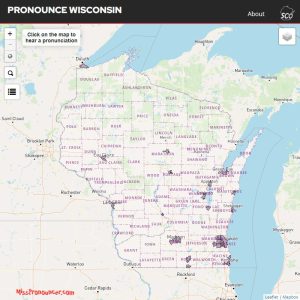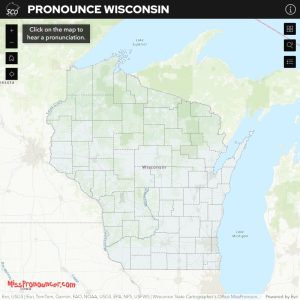We are thrilled to announce that the updated Pronounce Wisconsin web application is now live and ready to use. This modernized version builds on the original concept by offering a more intuitive, mobile-friendly, and accessible platform for exploring the accurate pronunciation of place names across Wisconsin.
If you’ve ever driven through the state and found yourself hesitating at road signs like Fond du Lac or Oconomowoc, you’re not alone. As a newcomer myself, I remember wondering, “Is that even English? Do I need to learn other languages to survive here?” And it’s not just out-of-state visitors who get tripped up. Wisconsinites might be surprised to learn there’s a Menominee County in the east and a Menomonie town and city in the west, with different spellings!
What began as a practical tool has also become a way to connect with others through shared experiences and funny mistakes. One of the most rewarding parts of this project has been hearing stories from people who’ve mispronounced places, struggled with spelling, or simply wanted to know the right way to say a name they’ve seen for years.
1. Why Are Wisconsin Place Names So Hard to Pronounce?
Many of Wisconsin’s place names originate from Native American languages, particularly those of the Ojibwe, Menominee, Ho-Chunk and Potawatomi people. If you are curious, a comprehensive Wikipedia list highlights many of them. Over time, although the spellings often stayed close to the original, the pronunciations shifted significantly. These changes happened as English, French, or German-speaking settlers adapted the names to their own phonetic systems. For a more accurate idea of how some of these names originally sounded, you can explore resources like “Wisconsin as Spoken by the Menominee” from the College of the Menominee Nation.
Following the Indigenous presence, French explorers and missionaries arrived in the 17th century. They named places such as Prairie du Chien and Fond du Lac. These names were later altered in pronunciation by English-speaking settlers and no longer sound like their French originals. In the 19th century, large waves of German and Scandinavian immigrants moved into the state. These groups brought their own languages, traditions and culture. Place names such as Stoughton, New Glarus and Sheboygan reflect their influence.
The combination of Native American roots, French naming, and German and Scandinavian settlement created a complex mix of languages and pronunciations. As a result, Wisconsin’s place names often serve as linguistic time capsules. They preserve the memory of earlier communities, even if their modern pronunciations have changed.
This web application is not just the result of our own efforts. The inspiration originated from MissPronouncer.com, an audio pronunciation lookup platform created by Jackie Johnson and published since mid-2005. Thanks to Jackie’s work, we now have reliable audio clips for anyone curious about the correct pronunciation of Wisconsin place names.
The idea for MissPronouncer came when I struggled to find accurate pronunciations of Wisconsin locations while prepping for the early morning radio newscasts. Nobody was around with whom I could confer at 4:00 in the morning. Something had to be done. An idea was born. – Jackie Johnson
2. Why Is It Time to Embrace New Technology?
The previous version of Pronounce Wisconsin was built using Carto, Leaflet and Mapbox. While it successfully delivered the core functionality, we are consolidating our applications in a single ecosystem to make them easier to maintain over time. In this updated release, we have migrated to the ArcGIS Online ecosystem, using Experience Builder to create a more scalable and maintainable solution. This transition better aligns the project with modern application infrastructure and prepares it for future integration and expansion.


▲ Previous and current versions of Pronounce Wisconsin
By leveraging ArcGIS Online’s built-in tools and ready-to-use features, the new version of Pronounce Wisconsin offers significantly improved maintainability. Tasks that once required custom coding or third-party plugins are now handled within a unified platform, reducing technical overhead. Additionally, data hosting and management are streamlined through ArcGIS Online’s cloud-based environment, enabling easier updates, centralized control and better collaboration. The platform also ensures seamless mobile accessibility, allowing users to access and interact with the application across devices without additional configuration. Together, these enhancements create a more efficient, scalable and user-friendly solution.
3. Experience Builder vs. Instant Apps: What’s the Difference?
During development, we thoroughly tested and evaluated both Instant Apps and Web Experience Builder, switching back and forth to compare their capabilities. To keep the application simple, intuitive and user-friendly, we chose a layout without side panels or excessive interface elements. Our focus remains on the core functions essential for learning place name pronunciations, including audio playback, place name search and other tools that directly support pronunciation learning without unnecessary distractions.
▼ Comparison of Instant Apps and Experience Builder functionality
| Instant Apps – Basic | Experience Builder | ||
| Audio Play | Click/Touch to play | ✔️ | ✔️ |
| Replay multiple times | ✔️ | ✔️ | |
| No popup player | ✔️ | ✔️ | |
| Search | ArcGIS Geocoding | ✔️ | ✔️ |
| Search data layer | ✔️ | ✔️ | |
| Click on the result to play audio | ✔️ | ✔️ | |
| Basemap | Component | Toggle⚠️ | Gallery |
| Number of options | 2⚠️ | Many | |
| Loading time | Faster | Slower⚠️ | |
| Popup | Position | Upon featureor Fixed (4 options) | Upon featureor Dock (6 options) |
| Map | Customize default view | ✔️ | ✔️ |
| Layout | Customize button position | ✔️ | ✔️ |
| Hint Message | Show hint message on the frame | On Web Map⚠️ | ✔️ |
4. Roadblocks (and How We Overcame Them)
One of the first challenges we encountered was implementing audio playback. Although map pop-ups support the HTML <audio> tag, our goal was to deliver a smooth and intuitive user experience. This meant more than simply enabling autoplay, as we also wanted to hide the playback controls and ensure the audio would automatically play whenever a user clicked on a location. By removing the “controls” attribute, we were able to hide the audio panel, and by adding the “autoplay” attribute, we enabled a seamless click-to-play functionality within the pop-up.
To improve the search experience, we aimed to restrict results to only those places displayed on the map. Our objective was to allow users to search, zoom to the selected location, and immediately hear the correct pronunciation. We accomplished this by configuring custom search sources available in both Instant Apps and Experience Builder.
Enhancing the map’s visual intuitiveness was another important step. The default scale-dependent symbology in ArcGIS Online appeared too subtle to meet our design standards. To address this, we opened the Web Map in ArcGIS Pro and manually defined scale stops for each relevant layer. This approach allowed us to deliver clearer, more responsive symbology that adjusts dynamically as users zoom in and out.
In keeping with the legacy version of the application, we also needed to feature the MissPronouncer.com logo in the bottom-left corner to recognize Jackie Johnson’s contribution. Additionally, we wanted to display a hint message in the top-left corner to help guide first-time users. However, Instant Apps lacked support for these custom interface elements. While we were able to embed the logo directly into the Web Map, it remained fixed to a geographic coordinate instead of staying anchored to the application interface, which limited its usability.
This limitation proved to be a decisive factor in our development process. When we tested the same layout in Experience Builder, we found that it fully supported custom logos and on-screen text within the app frame, fulfilling our design and usability requirements. This capability became one of the key reasons we ultimately chose to build the final version of Pronounce Wisconsin using Experience Builder over Instant Apps.
5. The New App
We hope you continue to use and enjoy the Pronounce Wisconsin app, and find it useful when encountering a new place name you haven’t heard before. Our goal is to help you speak like a Wisconsinite, even if you don’t come from here!
One might not use this type of resource every day, but it’s good to know this reliable audio map is readily available when one needs to know accurate pronunciations for Wisconsin locations. – Jackie Johnson
